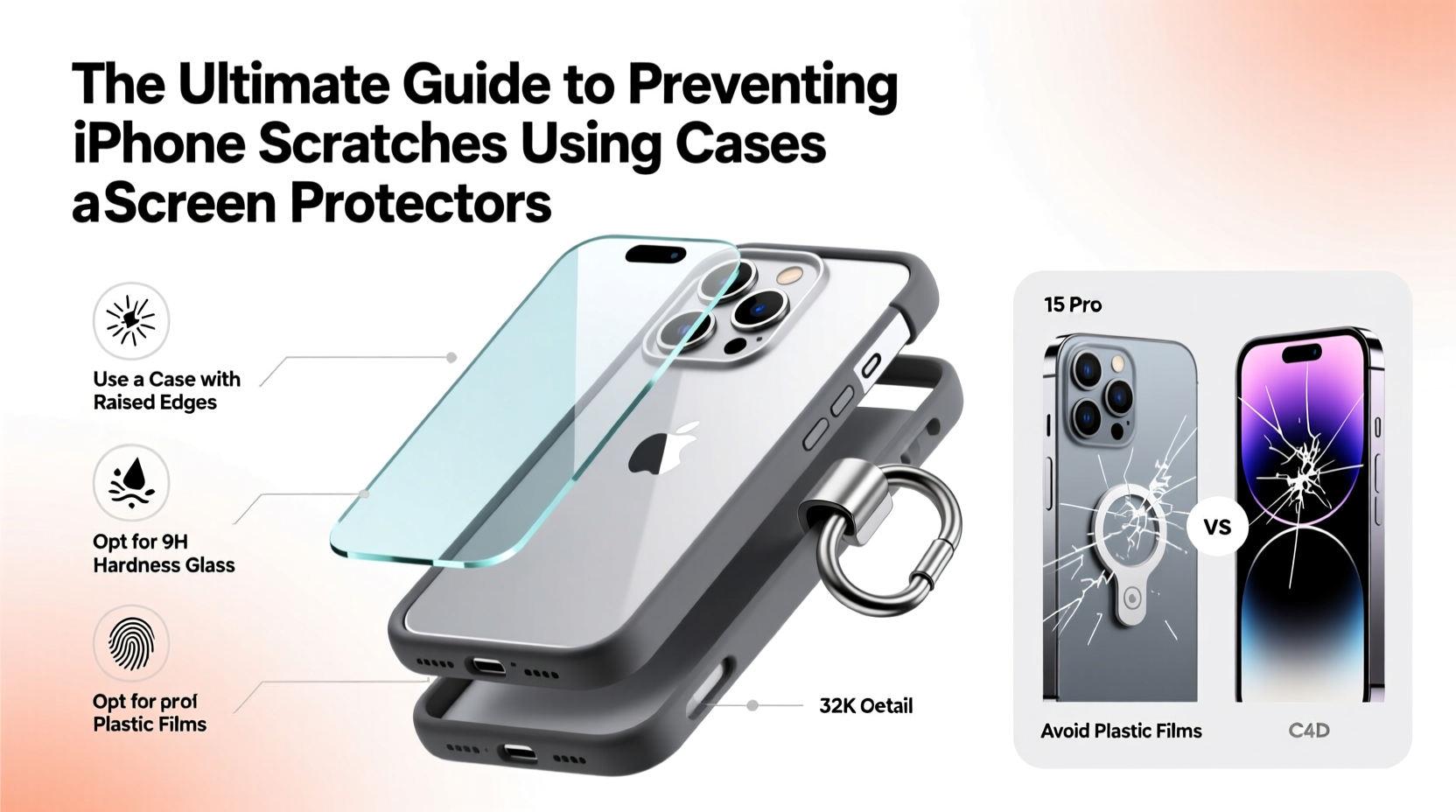Your iPhone is a precision-engineered device designed for both performance and aesthetics. Yet, even with careful handling, it’s nearly impossible to avoid minor wear over time—especially surface scratches on the screen and back glass. While Apple uses durable materials like Ceramic Shield and textured matte finishes, no phone is immune to abrasion from keys, coins, or rough surfaces. The good news: most scratches are preventable. With the right combination of protective gear and mindful habits, you can keep your iPhone looking pristine for years.
Understanding What Causes iPhone Scratches

Scratches don’t happen overnight. They result from repeated exposure to abrasive materials. The Mohs hardness scale helps explain why certain objects damage your phone. For example, sand particles (quartz) rank around 7 on the scale, while iPhone screen glass typically ranges between 5.5 and 6.5. This means that everyday dust or grit in your pocket or bag can slowly etch micro-scratches into the surface.
Common culprits include:
- Keys and coins in the same pocket or purse
- Laying the phone face-down on rough surfaces like concrete or gravel
- Dust buildup inside poorly sealed cases
- Using low-quality screen protectors that degrade quickly
“Most iPhone damage starts not with drops, but with unnoticed micro-abrasions. These accumulate and compromise both appearance and resale value.” — Jordan Lee, Mobile Device Durability Analyst at TechGuard Labs
Choosing the Right Case: Your First Line of Defense
A high-quality case does more than absorb impact—it prevents direct contact between your iPhone and abrasive environments. Not all cases are created equal, though. Materials, fit, and design play critical roles in scratch prevention.
| Case Material | Scratch Resistance | Pros | Cons |
|---|---|---|---|
| Silicone | Moderate | Soft grip, shock-absorbent, retains color well | Can attract lint; may discolor over time |
| Polycarbonate (Hard Plastic) | High | Resists surface abrasion, slim profile | Less impact protection; shows fingerprints |
| TPU (Thermoplastic Polyurethane) | Good | Flexible, durable, excellent grip | May yellow after prolonged sun exposure |
| Hybrid (TPU + Polycarbonate) | Very High | Combines flexibility and rigidity; maximum protection | Bulkier; higher price point |
Selecting the Best Screen Protector
The screen is the most vulnerable part of any smartphone. Even minor scratches can become glaring under bright light. A reliable screen protector acts as a sacrificial layer, taking damage so your actual display doesn’t have to.
There are two main types:
- Tempered Glass Protectors: Typically rated 9H hardness, these mimic the feel of the original screen. They offer excellent clarity, touch sensitivity, and edge-to-edge coverage. Look for models with oleophobic coating to resist smudges.
- Plastic (PET or TPU) Films: Thinner and cheaper, but less durable. TPU options are better for curved screens due to their flexibility, though they scratch more easily than glass.
When installing a screen protector, cleanliness is crucial. Dust particles trapped underneath create bubbles and weak points where scratches can start.
Installation Checklist
- Clean hands and workspace
- Use included alcohol wipe and microfiber cloth
- Work in a low-dust environment (e.g., bathroom after a shower)
- Align carefully before pressing down
- Use the squeegee tool to remove air bubbles
Real-World Example: The Commuter’s Dilemma
Consider Sarah, a marketing executive who commutes daily via subway. She keeps her iPhone in her shoulder bag alongside keys, a metal water bottle, and notebooks. Within three months, her phone developed fine webbing of scratches on the back and small nicks near the camera ring. After switching to a hybrid polycarbonate case and applying a 9H tempered glass screen protector, she noticed immediate improvement. She also began using a dedicated inner pouch for her phone. Six months later, her iPhone looked nearly new—proof that small changes yield long-term results.
Daily Habits That Make a Difference
No amount of protection compensates for poor handling. Integrating smart routines into your day significantly reduces the risk of scratches.
Key habits to adopt:
- Keep your phone separate from loose metal objects in pockets or bags.
- Regularly clean your case by removing it and wiping both the phone and interior lining.
- Avoid stacking items on top of your phone in backpacks or purses.
- Replace worn-out screen protectors—even invisible micro-cracks reduce effectiveness.
Frequently Asked Questions
Do all iPhones scratch easily?
No two models are identical. Newer iPhones use tougher materials—like Ceramic Shield on the front (up to four times better drop performance) and textured matte glass on Pro models that hide fingerprints and micro-scratches better than glossy finishes. However, no consumer phone is scratch-proof under real-world conditions.
Is a screen protector really necessary if my phone has Gorilla Glass or Ceramic Shield?
Yes. While these technologies improve durability, they aren’t invincible. Ceramic Shield resists drops better than scratches. In lab tests, even Ceramic Shield shows signs of abrasion when exposed to materials above 6 on the Mohs scale. A screen protector adds an extra layer that’s easier and cheaper to replace.
How often should I replace my screen protector?
Inspect it monthly. If you notice visible scratches, reduced touch sensitivity, or lifting edges, replace it immediately. Most quality protectors last 6–12 months under normal use. Delaying replacement increases the chance of damage transferring to the actual screen.
Final Recommendations: Building a Scratch-Proof Routine
Preventing iPhone scratches isn’t about one perfect product—it’s about creating a layered defense. Start with a well-fitted, high-quality case made from scratch-resistant materials. Pair it with a 9H tempered glass screen protector applied correctly. Then reinforce these choices with consistent habits: keep your phone clean, store it separately from sharp objects, and inspect your gear regularly.
Remember, every scratch begins as something invisible. By acting early and consistently, you preserve not just the look of your device, but its functionality and future resale value.









 浙公网安备
33010002000092号
浙公网安备
33010002000092号 浙B2-20120091-4
浙B2-20120091-4
Comments
No comments yet. Why don't you start the discussion?